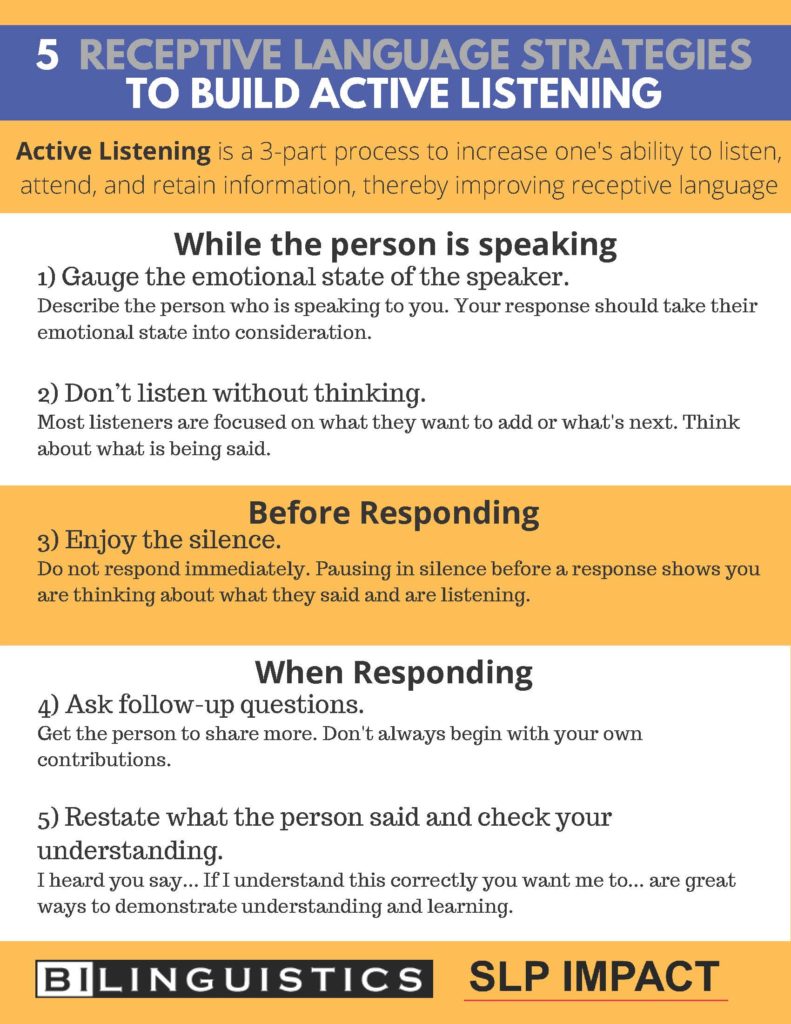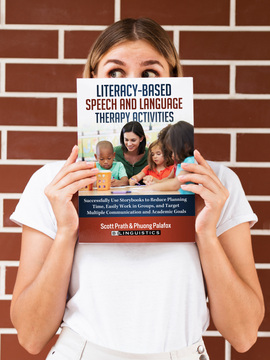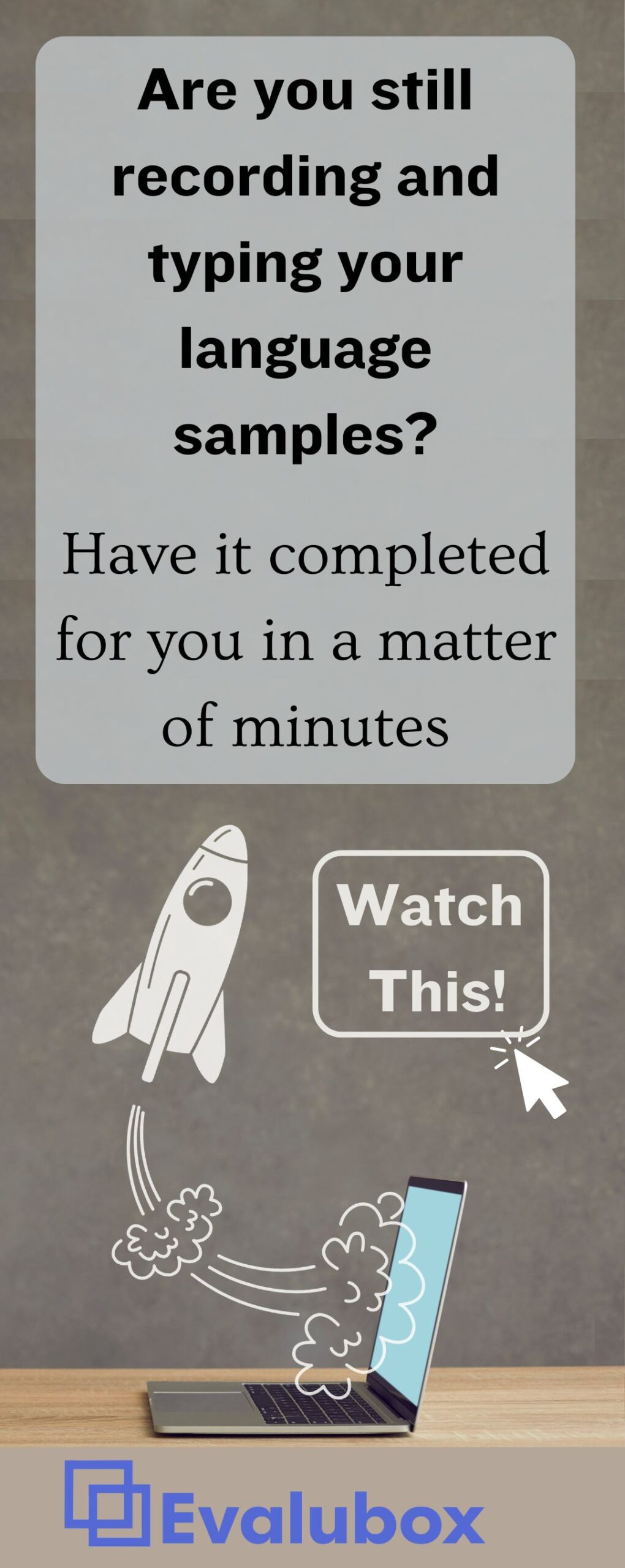SLPs have long since relied on tired-and-true receptive language disorder strategies to help students increase attention, increase retention, and enable a child to demonstrate learning to a teacher.
But what if they don’t work like in this case?
I have students who can do all the receptive language activities that you can think of, but their teacher still complains about “retention.” Also, it’s obvious they aren’t paying attention during a conversation, they disrupt someone who is talking, or what they say next is completely off topic. What do we do here to finish off their receptive language goals?
This is an awesome question and what it is getting at is something we don’t often talk about or focus on in speech therapy:
How do we generalize receptive language skills across conversation and academic environments?
There is a body of research that falls into the camp of “Active Listening” which primarily focuses on improving work interactions and relationships. How they define receptive language skills is extremely unique because it takes into consideration both partners, the time while listening, the time after listening, and then how a person responds.
What is Active Listening?
Active listening is a style of listening, waiting, and responding that enables a listener to understand, retain, and correctly respond to what is being said. Active listening is requires the listener to use all of the senses and is additionally successful at defusing situations and making a speaker feel heard and understood.
In this essay we are going to take their research and show how successful it can be as receptive language disorder strategies.
Before we dive in, hopefully you will see the power of active listening not only as receptive language interventions but also as a way to improve your parent interactions and IEP meetings. Here is an overview in an infographic that you can download from our Speech Therapy Materials Page. Then we will talk through them one by one.

Active Listening Receptive Language Skills List
I want you to think of any two people speaking. If you are like me before reading about active listening, I saw conversation as a give-and-take. Some information stuck, some information didn’t. I now want you to slow the conversation down to half speed, just like in the movie The Matrix. The is 1) someone talking, 2) the space between when someone talks and someone responds, and 3) the response.

We are going to take a look at five receptive language skills. The first two have to do with what to do WHILE a person is talking. The third covers the space in between. The last two deal with the response and is where we typically focus on receptive language disorder strategies. However, active listening provides us with a twist.
1) Gauge the emotional state of the person.
The first idea is to gauge the emotional state of the person speaking. We know that a big percentage of communication is non-verbal. So how excitable is this person? How upset are they? How sad are they? How happy are they when they’re talking to you? What is their body language? What is their facial expression?
I think we’ve all been in a situation where we’re saying something that’s really, really intense or really serious. And the reaction of the person we are speaking to doesn’t meet us with the same level of intensity. With students, maybe they laugh or their reaction is emotionally completely off. Think about children who are completely caught off guard when a teacher “explodes” because they didn’t clue into the escalation.
There are two aspects that are super cool about his idea:
- We haven’t even said anything yet! There are a lot of receptive language examples like identifying a character’s emotions or pointing at a smiley-face-chart to share our feelings that never get generalized to full conversation. Describing a movie characters emotional state or a conversational partner brings the lower-level skills into full conversation.
- Secondly, this can be used in reverse. We can meet a child’s sour response with animation or deescalate their anxiety by addressing it before we move into our typical response. This requires us to also improve the way we observe.
2) Don’t listen without thinking.
The second pre- receptive language skill is: don’t listen without thinking. Typically, a person is formulating the next thing they want to say while another person is talking. The response may relate to the topic but probably doesn’t relate at all to what the person said. We will get into this more with the last two active listening suggestions but here are two examples. Which one was listening without thinking?
Topic: Our car broke down
Speaker:
Our car broke down yesterday when it was really hot out. I was stuck on the side of the road with my dad until my mom got off of work and came to get us.
Listener responses:
- A: It was hot. That’s why we went to the beach. I got this new inflatable that…
- B: I saw a car on the side of the road once with the tire blown out.
- C: Oh, want to get something to eat?
- D: That must have been hot. Were you scared?
So it’s not just the idea of listening actively. But what are you actually doing inside of your head? What are you thinking? When a person is talking, can you cue yourself to truly pay attention?
3) Enjoy the silence.
The third receptive language disorder strategy is kind of cool because it taps in at the subconscious level of the conversation. It is also super easy. After someone’s done speaking, what do you do? How quickly do you respond?
While we may think that an immediate response is the right thing to do, silence can actually convey better intent. Silence says: I’m patient and listening. Are you done or did you just pause? Silence say: I’m thinking about what you just said.

Weren’t not talking about an awkward pause. But how about one second with a head nod or a look up to the right to process what you just heard.
And the suggestion here is to enjoy the silence. After learning about this I had the displeasure of listening to myself in a parent meeting and when working with a child. I had recorded the session to capture the articulation sample. Man was I bad! For one, I saw I needed to cut back on the coffee. I was a complete motor mouth. The second thing I learned is that when give the space, most people will pause and just keep talking. This is so much more enjoyable and with parents doing intakes you get so much better information.
4) Ask follow-up questions.
With these last two strategies we are back into the familiar territory of our receptive language interventions. What is it that we actually say after someone has just finished speaking? what do you The first suggestion is that you ask a follow-up question.
The goal of active listening is to get a better understanding of what the other person is trying to say. Responding with a comment, even if it is on topic, probably doesn’t get us there. A follow-up question either gets us to a deeper understanding or confirms that we understood correctly. Both are wins.
5) Restate what the person said and check your understanding.
We have saved the best for last because this strategy has gotten me the most thank-yous at work and at home since I have been employing it. Here are three response starters that work wonders and can easily be taught to students in groups. They are already being taught in other formats to check their work, review their problems, or restate the scientific aim. This is our communication version.
So, I hear you saying…
Tell me if I understand correctly,
What I heard you say was…
At its essence, I think active listening is the dynamic assessment of our receptive language disorder strategies. We test, teach, and retest to make sure we understood. Receptive language strategies used this way enables a child to dynamically assess their own interactions.
Learn More:
The 6 Most Productive Receptive Language Activities

The Power of Receptive Language – Earn CEUs and improve your receptive language game!


 Share
Share
 Tweet
Tweet
 LinkedIn
LinkedIn
 Pin
Pin
 Email
Email


